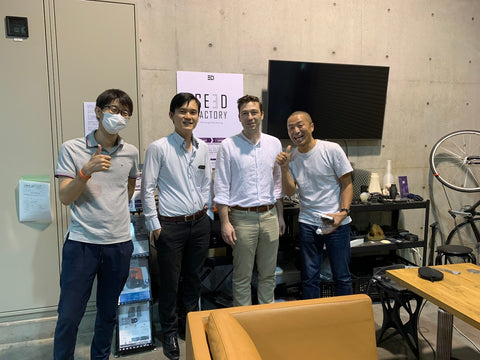
今回取材にご協力いただいた小田垣様は、ご趣味で自転車に乗られています。自慢のマシンは、後ろへ寄りかかり気味に漕ぐ特殊な形状をしたもの。しかし、近頃困った事態に見舞われていました。破損してしまった自転車パーツの代替品が特殊な形状であったため、すでに市場にはなかったのです。増産を頼もうにも、小ロット生産では採算が合わないために同じものが入手できる見込みが低く、途方に暮れてしまいました。
そんなお悩みをまさに解決するのが、3Dプリンティング技術。3D Printing Corporationの3Dコンサルティング事例として、小田垣様の自転車パーツ再生の過程を紹介いたします。
導入の背景:特殊パーツの代替品を求めて
破損したパーツは、ペダル部と後輪部を結ぶチェーンの中継歯車を覆う保護板部分です。中継歯車が上面から見て横へ少々突き出しているため、ピンと張ったチェーンが保護板へ常にこすれ、力がかかり、やがて破損に至ったようです。該当パーツの再入手が困難であると判明した時、小田垣様はまず自力での修復を試みたそうです。市販の接着剤を用いてパーツを取り付けなおすという荒業を施したそうですが、強度が低下していたためか、1・2か月ほどでまた割れてしまいます。


次に、小田垣様は金属部品加工の工場をお持ちの弟様に、該当パーツの作成ができないか問い合わせてみます。回答としては、「難しい」の一言。既存の金型を作って作成する方法では、少なくとも数十個規模の注文がなければ製造へは踏み切れず、それでも単価当たりのコストが莫大なものになってしまうとのこと。今回パーツがなくて困っているのは小田垣様一人だったため、とても現実的ではありません。
手詰まりに悩まされていたころ、奇しくも3Dプリンティングによる自転車製造について、弊社3D Printing CorporationのCTOである古賀が述べている記事を見かけたそうです。以前から古賀やCEOと知り合いであった小田垣様は、3Dプリンティング技術であればパーツを製造できるのではないかと思い立ち、ご連絡くださいました。

運用方法と効果:新規パーツ製作のスピードと新規パーツのレベルアップ
ご依頼を受け、3D Printing Corporationの3Dプリンティングソリューションが始まります。まずは、該当パーツの寸法と写真をメールで送っていただき、そこから推測でパーツを3Dプリントしました。「せっかくなので格好いいデザインにしたい」という小田垣様の要望も受け、デザインチームが工夫を凝らします。情報を得てから、3Dデータが完成するまで、わずか1時間未満。熟練の技が光ります。のちの造形は、放っておけば3Dプリンターが1日以内に行ってくれます。

完成したプロトタイプパーツを小田垣様に送付し、確認を行っていただいたところ、うまく機能しないことが判明しました。事前の情報が不足していたため、これは仕方がありません。ここからは、コンサルティングに入ります。パーツの機能とは何なのか、どのような形状ならば、その目的が達成できるのか。既存のパーツを理解するために、許可をいただいて分解も行いました。
その結果、パーツはチェーンの中継器具であり、初期形状と同じただの保護板として取り付けるのではなく、自身も回転することによって滑らかな駆動が期待できるのではないか……と、デザイナーチームは考えました。要点を抑えたコンサルティング、そして改善案のデザインについても、正味1時間程度で完了します。
さあ、3Dプリンターに造形を任せ、出力が完了したら実地で試運転です。
「ちゃんと機能しています! 格好いい。本来こうあるべきですよね!」
実物を見て、開口一番大歓喜する小田垣様。デザインチームの工夫により、ボールベアリングが仕込まれた該当パーツは、以前とは比べ物にならないほど滑らかに駆動するようになっていました。材料は、頑丈で表面の滑らかなエポキシ樹脂(EPX82)。チェーンのこすれも大幅に軽減され、今度は長持ちしそうです。
「最初に購入した時から、チェーンがこすれて耳障りな音がしていたんです。そんなものかな、と諦めていたのですが、こんなに改善されて感動しました」と、小田垣様は絶賛します。

今回改善を提案した3D Printing CorporationのDFAMエンジニア:山路は、少し照れくさそうにしながらも工夫点についてコメントしました。
「ボールベアリングを埋め込む関係上、外れないようにどうしてもはみ出る部分が出てきます(下図参照)。本来ここは宙に浮いてしまい、サポート材なしには造形できず、取り外したりきれいにするのに手間がかかったはずなんですが、今回選択した3DプリンターCarbonであれば、この程度なら宙に浮いたまま造形できるんですよね。Carbon DLS™プロセスという、魔法のような技術です」

3Dプリンティングであれば、今回のように生産が終了してしまったパーツも再生・改善出来ます。特記するべきことは、データとして保存可能なため、さらにこのパーツが破損してしまったとしても、何度でも造形しなおせるという点です。しかも、自宅や近所の3Dプリンター設備でも作れる※のです。これは、製造にロット数の必要な既存の射出成形技術では真似できない部分です。
※工業用グレードの3Dプリンターを使わない場合、質に大きなばらつきが生じる恐れはあります。
今後の展望
リニューアルパーツを組み込んだ自転車をひとしきり楽しんでいただいた後、小田垣様に感想をいただきました。
「乗り心地が違いますね。感動です。弟の工場にも3Dプリンターがあるのですが、こんな風に活用はされていません。素人が3Dプリンターを使おうとしても、既存のものを作るに留まってしまいます。ペン立てのような置物の程度のものを作って、おしまいです」。
それを受けて、3DPCの山路もうなずきます。
「パーツの役割や、構造をきちんと知れば、より良い方法も出てきます。今回のボールベアリングなんかはそのわかりやすい例ですね。3Dプリンターならば、これまでは難しかった複雑な形状でも造形可能ですから」。
「まさに3D Printing Corporationさんの強みはそこです。機械の設計やデザインに精通した技術者さんがいらっしゃって、それぞれ専用の3Dプリンターも備えていて、すべて一社で賄えるところ。わずかなコンサルティングからもヒントを見つけて、的確により良いパーツを造形してくれました」。
